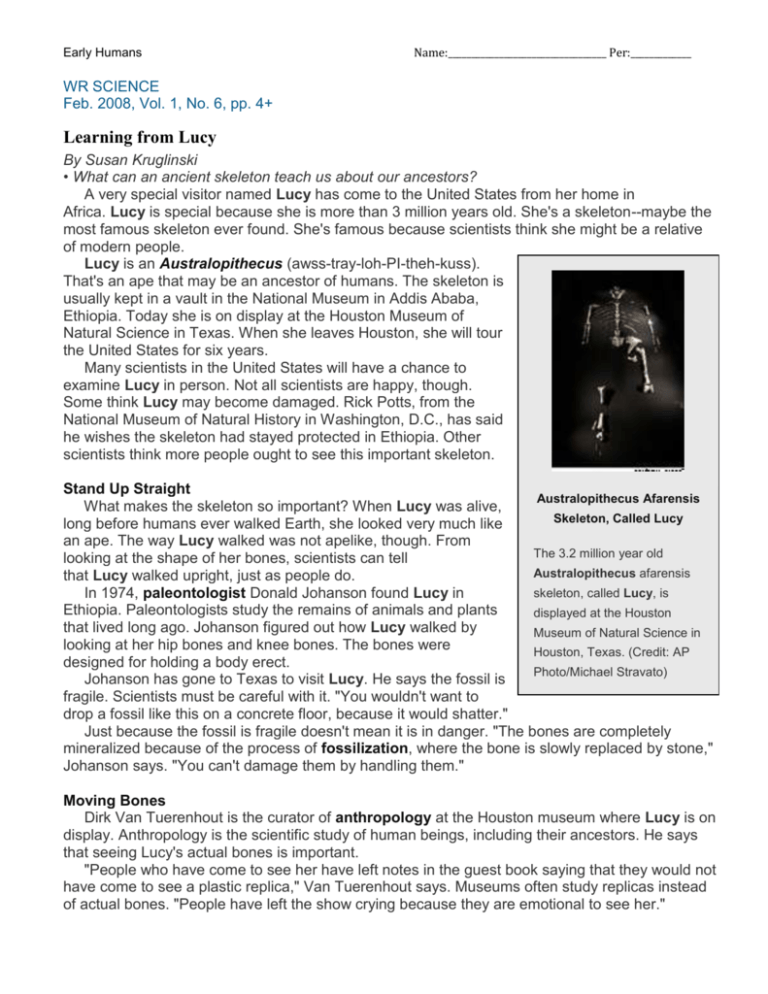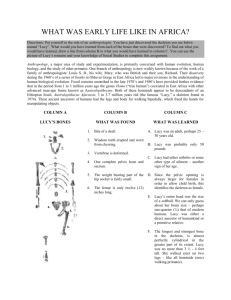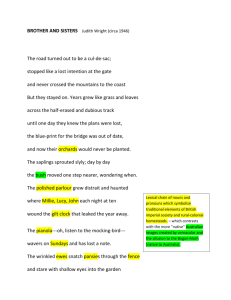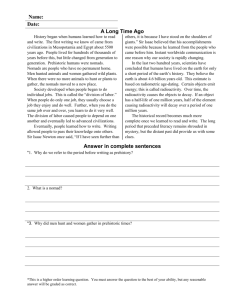"Learning from Lucy" article
advertisement

Early Humans Name:__________________________________ Per:_____________ WR SCIENCE Feb. 2008, Vol. 1, No. 6, pp. 4+ Learning from Lucy By Susan Kruglinski • What can an ancient skeleton teach us about our ancestors? A very special visitor named Lucy has come to the United States from her home in Africa. Lucy is special because she is more than 3 million years old. She's a skeleton--maybe the most famous skeleton ever found. She's famous because scientists think she might be a relative of modern people. Lucy is an Australopithecus (awss-tray-loh-PI-theh-kuss). That's an ape that may be an ancestor of humans. The skeleton is usually kept in a vault in the National Museum in Addis Ababa, Ethiopia. Today she is on display at the Houston Museum of Natural Science in Texas. When she leaves Houston, she will tour the United States for six years. Many scientists in the United States will have a chance to examine Lucy in person. Not all scientists are happy, though. Some think Lucy may become damaged. Rick Potts, from the National Museum of Natural History in Washington, D.C., has said he wishes the skeleton had stayed protected in Ethiopia. Other scientists think more people ought to see this important skeleton. Stand Up Straight Australopithecus Afarensis What makes the skeleton so important? When Lucy was alive, Skeleton, Called Lucy long before humans ever walked Earth, she looked very much like an ape. The way Lucy walked was not apelike, though. From The 3.2 million year old looking at the shape of her bones, scientists can tell Australopithecus afarensis that Lucy walked upright, just as people do. skeleton, called Lucy, is In 1974, paleontologist Donald Johanson found Lucy in Ethiopia. Paleontologists study the remains of animals and plants displayed at the Houston that lived long ago. Johanson figured out how Lucy walked by Museum of Natural Science in looking at her hip bones and knee bones. The bones were Houston, Texas. (Credit: AP designed for holding a body erect. Photo/Michael Stravato) Johanson has gone to Texas to visit Lucy. He says the fossil is fragile. Scientists must be careful with it. "You wouldn't want to drop a fossil like this on a concrete floor, because it would shatter." Just because the fossil is fragile doesn't mean it is in danger. "The bones are completely mineralized because of the process of fossilization, where the bone is slowly replaced by stone," Johanson says. "You can't damage them by handling them." Moving Bones Dirk Van Tuerenhout is the curator of anthropology at the Houston museum where Lucy is on display. Anthropology is the scientific study of human beings, including their ancestors. He says that seeing Lucy's actual bones is important. "People who have come to see her have left notes in the guest book saying that they would not have come to see a plastic replica," Van Tuerenhout says. Museums often study replicas instead of actual bones. "People have left the show crying because they are emotional to see her." Early Humans Name:__________________________________ Per:_____________ Johanson also felt emotional seeing Lucy's bones. When he found them more than 30 years ago, he could tell right away they were not just the remains of an old ape. "And even now," he says, "when I visited the exhibit, I think my heart beat a little faster when I walked in the room and saw her again." Ape or Human? Lucy was not a human. Humans belong to the species Homo sapiens. Lucy's species is named Australopithecus afarensis. Lucy probably looked a lot like an ape and a bit like a human. Her arms dangled like an ape's, but she had longer legs than apes do. She had a flat face with a big brow and a wide jaw. She was probably very hairy. Scientists are almost certain that Lucy was around 25 years old when she died. They could tell from her jaw that she had wisdom teeth. In humans, wisdom teeth usually appear when people are between 16 and 25. Even though Lucy was an adult, she was only 3½ feet tall. Before Humans Scientists learn about human ancestors by studying fossils. They can tell that apelike creatures began to look more human over millions of years. However, tracing the human branch of the family tree is not easy. Lots of skeletons that have been found look as though they might be human ancestors. Scientists can't know for sure, however, if they really were direct ancestors or just distant relatives. Some old skeletons are from Australopithecus afarensis and Homo habilis. Some more recent skeletons belong to Homo erectus and Homo neanderthalensis. Lots of Lucys Scientists gave the skeleton the nickname "Lucy" after a song by the Beatles called "Lucy in the Sky With Diamonds." Since Lucy's discovery 33 years ago, many other examples of her species have been found in Africa. Recently, scientists found the skeleton of an infant that has been called "Lucy's baby." It is not really Lucy's baby, but it is the same species. "We now have close to 400 specimens of individuals who are of Lucy's species," says Donald Johanson. "Because of this, Australopithecus afarensis, which lived some time between 3 [million] and 3.8 million years ago, has become one of the best-known species of one of our distant ancestors." An Artist's Idea of Lucy's World The part of Africa where Lucy's bones were found is dry. When Lucy was alive, the area had more water and lots of plants. Amazing Ape Australopithecus walked upright like a human. It might have carried its babies as a human does too. The babies probably couldn't grab well with their feet as monkeys do. Reaching Out Long arms might have helped Australopithecus climb trees. Some scientists think it slept in trees for protection. Eat or Be Eaten? Australopithecus ate a lot of plants. It was probably eaten by big meat eaters in Africa, including crocodiles.








